These are articles and resources related to Faith and Phoenix: Convening in Arizona after SB1070, a series about how faith based groups with national conventions scheduled in Phoenix responded to Arizona’s image crises during and after the passage of SB 1070; check out Part 1 here.
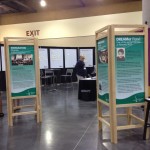 “I personally was of the opinion that it was a real opportunity for us to shed light on the issue nationally by going,” said Unitarian Universalist President Peter Morales.
“I personally was of the opinion that it was a real opportunity for us to shed light on the issue nationally by going,” said Unitarian Universalist President Peter Morales.
He told the local congregations and advocacy groups, “I need for you to invite us; that will break the boycott.”
And they did, allowing the 2012 Unitarian Universalist Association of Congregations convention to take place from June 20 to June 24.
“That’s what made the whole thing work because of what we did because it was clearly the most effective public witness we’ve ever done was on this issue, that we committed to working in close partnership with local people. So our local people worked locally, at the national level we worked with national staff of the National Day Laborer Organizing Network, groups like that.”
For Morales, the issues are larger than a particular state’s current political climate.
“I kept saying Arizona is not really about Arizona; immigration isn’t even about immigration for us,” Morales said. “I mean it’s really about the human rights and national issues and if we just go and have a terrific demonstration outside the tent city and congratulate ourselves and go home we will have done nothing at all.”
Unitarians often partner with organizations from other religious backgrounds including the United Church of Christ, the Catholic Church, evangelical congregations and Jewish organizations.
“It speaks to the common values of all the faith based institutions,” Morales said. “It goes to a commitment that so many faith based groups have around respect for human dignity, the core value of compassion and openness and in treating everyone as having inherent worth and dignity.”
When it comes to working with Mennonites, they’ve got tremendous record of on the ground kind of involvement, really hands on,” Morales said.
Now the Unitarians partnered with local groups like Promise Arizona to incorporate education and advocacy events into their convention program,.
“One of the big emphases of our conference was to not only demonstrate how it could happen but to instruct people on how to make alliances locally,” Morales said. “So churches working cooperation with grassroots organization and there’s been a lot of that going on around the country. The way we phrased it is ‘it build capacity.’ All indications are that it did.”
The partnership between local advocacy groups and the Unitarians also led to an ongoing immigrant rights issues project run by the Arizona congregation including Unitarian Arizona Immigration Ministry organizer Sandy Weir.
“What’s gratifying is that we work in preparation with some of the congregation and ministers did and it work is continued on immigration and in other issues, because the issues will change,” Morales said.
And that ongoing work is visible to Garcia.
“I see her with some regularity now because she shows up to these coalition meetings,” Garcia said. “They’re very active on that stuff. So that was the conscious thing on their part that they are going to essentially just, you know, we are going to deal with this as part of our convention and they put that right on the table.”
Weir also participated in a discussion with the U.S. Mennonite Church about their convention decisions as they too worked their way through tough decisions about their congregation members, their ideals and their 2013 convention location.
The U.S. Mennonite Church is the largest Anabaptist organization in the U.S. There are nearly 1000 US Mennonite church congregations in the US and about 1.7 million Mennonites in 83 countries worldwide, including growing congregations in Central and South America.
Immigration and the convention location are a few several contemporary social issues that are playing out in federal courts and small towns across the country – and triggering internal conflicts within the the U.S. Mennonite Church. These internal conflicts intensified after an official 1999-2003 merger between the General Conference branch, perceived to be more liberal, and the Mennonite Church branch, perceived to be more conservative. Additional debates during lead-up district conferences included whether Statements of Faith should exclude female pastors and disciplining member churches for performing same sex marriages.
The highly anticipated U.S. Mennonite Church convention events usually blend tackling tough topics with worship and church governance for members, who to outsiders are often indistinguishable from other Anabaptists branches in the U.S.: the Mennonite Brethren, the Church of the Brethren and the Amish.
The church’s official position on lesbian, gay, bisexual, transgender, and queer issues led to the formation Pink Mennos in 2008. Frustrated that they felt their issues weren’t being heard, Pink Mennos compared themselves to Lations in the congregation who felt marginalized and staged civil protests during the 2013 convention asking for their issues to receive equal recognition – an additional sign of changing dynamics and growing pains within the traditionally tightknit ethnic population of the church.
Garcia also noted that the changing makeup of the country’s population is affecting organizations.
“The demographics have permeated these groups,” Garcia said. “They’re large and a lot of them have sort of national reach, and a lot of them have been sort of actively recruiting minorities here either naturally or organically or you know consciously because of the changing demographics around the country.”
And that impacts how decisions are made.
“What inevitably happens is that they have board members now who’re Hispanic, or they have constituents,” Garcia said. “People have booked conventions because they’ve booked conventions three or four years ago and so they’re stuck internally as an organization with all the questions that you just outlined is it something philosophically that that group opposes, is not something that our membership that the people on our board opposed?”
News stories about SB 1070 seemed like a warning to many Latinos: “don’t come to Arizona because you’re going to get arrested,” Garcia said.
“I’m oversimplifying but not by much,” Garcia said. “That’s the message that’s being sent out and you’re Latino and you’re in Pittsburgh or you’re in Atlanta or in San Antonio and you’re a member of the board of one of these groups here and you’re thinking, ‘why are we going to go spend our money there, and being harassed and, you know why don’t we show solidarity with these folks?'”
In the Pacific Southwest Mennonite Conference, the district which includes Arizona, California and Nevada, Anglo Mennonites are actually a minority now. The majority of church members are first generation immigrants who come from all over the world and represent nearly a dozen languages, wrote Tucson’s Shalom Mennonite Fellowship Pastor Bryce L. Miller.
“As such migration and the consequences of it are primary for us,” Miller wrote in an email exchange. “They don’t always get called immigration issues– sometimes they come under names such as worship style, governance, cultural sensitivity, and theological assumptions, but ultimately they are immigration issues in a way for us that is not common for other more traditional conferences.”
With his state at the center of controversy for both his church and his country, Miller found himself in a unique situation as the pastor of a border congregation.
“Mennonites have long held that our citizenship is primarily that of the Kingdom of God, and that our calling as Christians calls us to live intentionally and sometimes critically within the national citizenship that we hold,” Miller wrote in an email exchange before the convention started. “Phoenix is a test of that conviction.”
Miller and his congregation witness and sometimes feel the effects of border security and humanitarian issues firsthand.
“This is not an academic issue in Pima County,” Miller wrote. “Hundreds of people die in the desert here. We live among the most militarized environment in the country.
Miller believes that his congregation has a responsibility to not take sides and to try to work with everyone involved.
“Our church is called to serve a community that houses both the undocumented on one hand and the border patrol and the other,” Miller wrote. “They are both our neighbors; how do we love both?”
Arizona pastors had a wide range of opinions similar to national leaders, Miller wrote.
“We are attempting to walk the line between solidarity with those hurt by our state’s policies, and our responsibilities as hosts,” Miller wrote. “We do not have the option to boycott our own state’s policies– not cleanly–despite our discomfort with them. So we are finding ourselves in the middle.”
Some leaders argued that the event could be “an opportunity for social witness and denominational learning,” similar to what the Unitarians had done.
There would also be serious financial consequences to canceling. According to the Mennonite Church USA website page discussing the 2013 convention decision, they faced losing estimated $500,000 which “would likely require significant reduction of our current staff and would make it very difficult to move ahead with the 11 commitments we have made to help us become a more anti-racist church and to work at the immigration problems in our national context.”
Significant arguments against supporting the state by coming were also made. Some Hispanic church members didn’t think they’ll feel personally safe at the convention.
“It is unsustainable for us to meet as the whole body of Christ in a place where some of our members could be harassed and perhaps persecuted for the immigration status,” Miller wrote. “We also take it seriously to commit denominational resources to a place where injustice is practiced.”
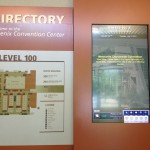 The Executive Board’s decision to stick with Phoenix as the 2013 convention location was difficult – and not everyone agreed with it.
The Executive Board’s decision to stick with Phoenix as the 2013 convention location was difficult – and not everyone agreed with it.
“There was a large and extensive re-processing of the decision with passionate debate on all sides,” Miller wrote. “This was a painful decision to those who are most affected, and continues to be.”
Some delegates pulled out and a few congregations like Dallas based Iglesia Menonita Monte Horeb officially decided not to send representatives. There’s no official tally of how many people stayed away, but several delegates cautiously estimated that convention participation was down by about 25% for a variety of reasons.
“Some of this is boycott,” Miller wrote. “Some of this is churches not wanting to/not able to expend the money to come to a western site as has been seen in previous conventions. Some of this is ‘Phoenix? July? No thanks.'”
Delegates said that discussion of a secondary meeting site with video links to Phoenix died because of either from lack of interest or concerns about creating a “separate and unequal experience.”
Now those attending from July 1 to July 5 faced the challenge of how to balance the competing views of the church and the local community they hoped to reach out to.
“While I respect the boycott, I just struggle with the impression that, that’s the only way to be in the solidarity and even if I want to, and sometimes I do, want to boycott my state, I can’t,” Miller said when I asked him about his observations during the first few days of the convention. “I’m here and this is where I am supposed to be.”
Yet the issues were kept by empty chairs on the worship stage that made a visual reminder of church members that had stayed away because of personal fears or support for solidarity.
“They are saying, these are the Hispanic brothers and sisters who don’t feel safe to come; these are the people who in conscience are absent in themselves; these are the people of all races and creeds who are made afraid by the environment that has developed here,” Miller said. “And as painful as that it is to hear as an Arizonan, it is something I understand.”
In a week with temperatures well over 100 all day and all night, Miller said he was watching many people who’d never been to Arizona get to know the state.
“Just the geography is completely unlike anything, anywhere else,” Miller said. “Then to overlay that foreignness with the circumstance of the immigration and all of that they’ve heard mostly good and bad about Arizona; it’s an interesting mix.”
In addition to lectures, plays and experiencing temperatures over 112 degrees for most of the week, nearly 200 people signed up to participate in border learning tours through Borderlinks.
“Inside the all air conditioned convention center is not all that real, relative to what’s out there either,” Miller said. “But I mean it is encouraging to have people that are really engaged in the conversation, engage on what’s there, I mean really willing to talk.”
Enjoyed the company of an Ohio Mennonite Church Youth Group as they visited my office while in town for a convention. pic.twitter.com/MQn1jyIgNc
— Joe Arpaio (@RealSheriffJoe) July 2, 2013
That willingness to talk extended past local advocacy groups to include local officials law enforcement, including the youth group from Ohio’s Kidron Mennonite Church who met with Maricopa County Sheriff Joe Arpaio.
Afterwards Sheriff Arpaio tweeted a photo where he posed with the smiling teenagers identified as convention participants and the image led to backlash from other delegates and local advocacy groups.
Some saw Arpaio’s actions as exploitative and were uncomfortable with the church being linked to any law enforcement group. Others were concerned about how it could be perceived by Latinos within the church who were already feeling alienated – and to the outside community.
Houston Pastor Marty Troyer pointed out the that elements of racial privilege were involved fact that while some church members felt confident meeting with Arpaio and other local officials, other church members feared even entering the state and said that both issues should be part of the continuing discussion on racial issues within the church.
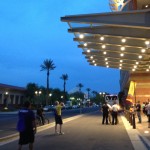 |
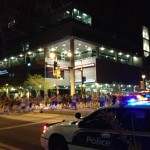 |
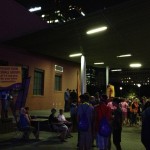 |
On the last day of the convention, Friday, July 5th, final worship services culminated in a peace walk.
The participants gathered at dusk, some surprised to find the building ringed by Phoenix Police vehicles. The officers provided traffic control as two groups of marchers led by church leaders carrying prayer banners left the Phoenix Convention center, one northbound and one westbound, who met again at the Civic Space Park. There they joined in hymns and prayers for their home congregations, the convention delegates and all those affected by the issues they’d tackled during the week.
The convention, which also included African, African American, Native American, Hmong and Indonesian delegates, celebrated the church’s diversity said delegate Jocelyn Graber from the Topeka, Kansas Southern Hills Mennonite Church.
“Tangential to the topic of immigration, there was also lots of conversation about assimilation not being a good thing, but that holding onto that which is significant to one’s culture is important in also shaping one’s faith,” Graber wrote afterwards. “There is gift in that, not only to the individual or to that cultural, but to all others who can learn from it and be in relationship with it.”
However the effects of Arizona’s much publicized tensions on the state’s image were also tangible. Due to the under representation of Latino congregations among the delegates, the 2013 convention did not produce a U.S. Mennonite Church denominational statement on immigration, Graber said.
“The subject of immigration was discussed, and somewhat put on hold because the people most affected by it were not able to be there,” Graber wrote. “It was agreed upon that we need their voices to complete the work of writing a more suitable statement on which we would then vote for or against.”
It’s a situation that could be as rich as it is challenging, according to Miller.
“We are in this position because we are in the west where the emerging patterns of our culture begin, and change is at its apex,” Miller wrote. “We are trying to translate what has been a somewhat monolithic denomination into the reality of multicultural reality and that is challenging, wonderful work.”
It’s all part of an figuring out who the church is and what its role should be in contemporary issues, especially at the state and national levels, wrote former University of Kansas instructor Ellen Kroeker who was grew up in the Mennonite church.
“The Mennonite church is still coming to grips with an emerging identity, from predominantly rural and small towns with a more homogenous identity, known by a set of common last names, to the reality of a rapidly changing, multi-cultural society,” Kroeker wrote. “The church is sorting its way through the issues of how much are they going to keep themselves separate from these changes and how much they are going to address them.”
The years of debate and decisions behind holding their 2013 national convention in Phoenix included discussions of religious, racial and economic issues. These issues are also being tackled by the Unitarians and by many other organizations – and families – across the state of Arizona and the rest of the country.

Leave a Reply